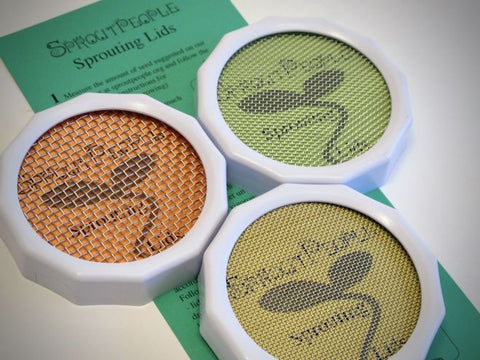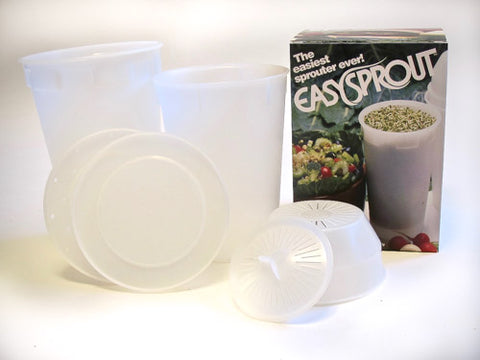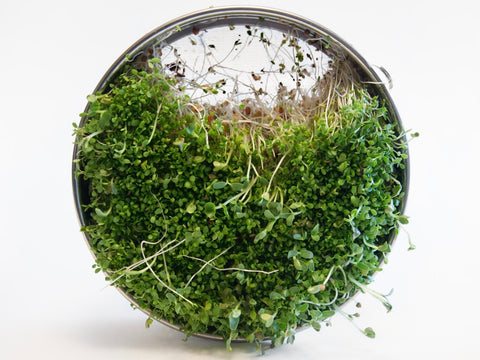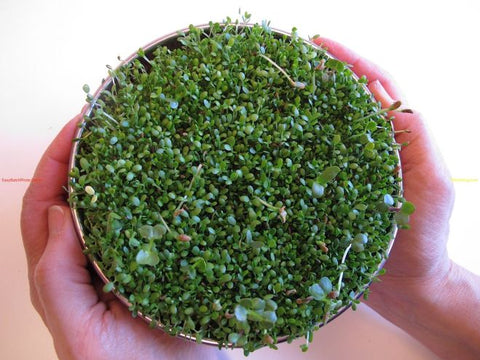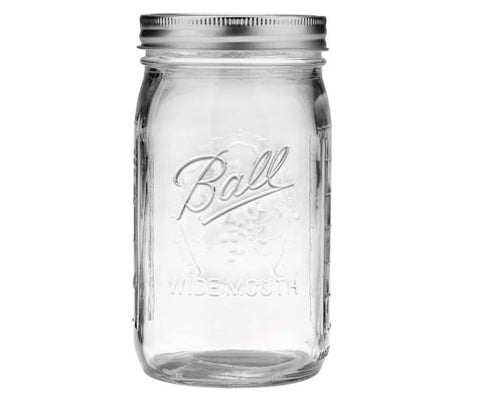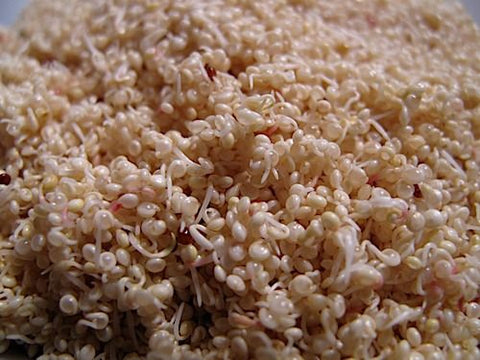
Amaranth Sprouts
A tiny ancient seed that produces one of the smallest of all sprouts. Use it on everything and anything - it looks super cool!
Vitamins A, B, C and E
Calcium, Iron, Magnesium, Niacin, Phosphorus, Potassium
Amino Acids
Protein: 15%
Rich and tiny texutred. Great as a carbohydrate-replacement side dish, or in a grain salad.
The amount of Amaranth Sprouts produced by 1 unit of Seed. For Example 2:1 means that 1 pound of Seed will produce 2 pounds of Sprouts or whatever crop you are growing. You do not have to grow them all at once of course, unless you wish to =:-D
The time it takes to grow a finished 2 - 4 days, or other crop (Micro-Greens, Grass, Greens) from a dry Seed. Note: This "finished" Sprout is our preference. you may grow them for as long as you want! In fact, we suggest that you taste them at every rinse to discover when you like them best.
How to Grow Amaranth Sprouts
Prep 2/3 cup of seeds by running cool water through them for a minute or so.
Soak the seeds in cool water for 30 minutes.
Drain off soak water. Do not ever soak again.
Rinse very thoroughly.
Drain thoroughly.
Keep your Sprouter in a relatively low light location.
Rinse and Drain thoroughly - with cool water every 8-12 hours.
Harvest when your seeds have tiny Roots, and eat or Refrigerate your crop.
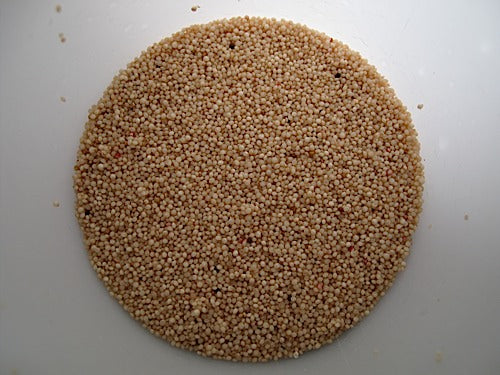
Dry Amaranth awaits Soaking.
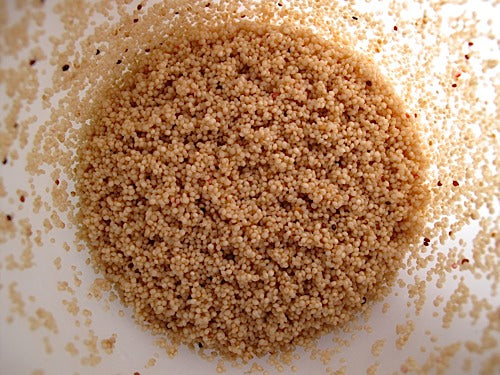
30 minutes later... Soaked, Rinsed and Drained thoroughly.
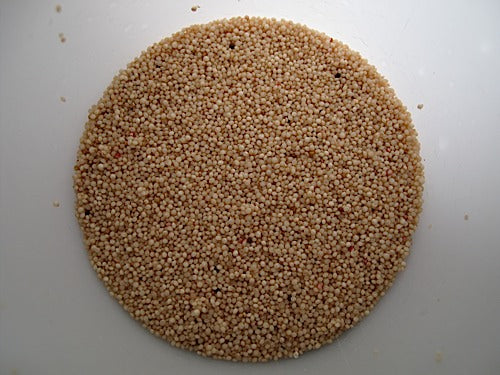
12 hours later... another Rinse/Drain cycle.Remember to be Thorough - especially in your Draining.
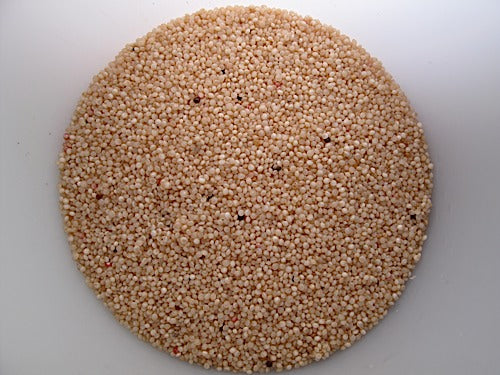
12 hours later... another Rinse/Drain cycle.Remember to be especially Thorough in your Draining, if you intend on following our advice - by harvesting in 12 hours.
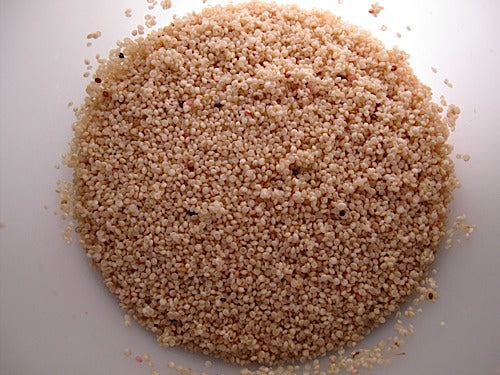
12 hours later... We would be done, and our Amaranth sprouts consumed or stored, but you keep going if you must. If you must - it's time for anotherRinse/Drain cycle.
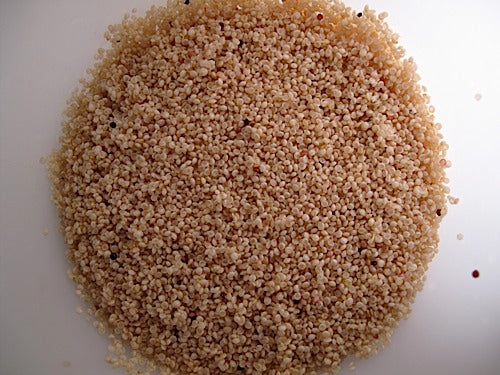
12 hours later... another Rinse/Drain cycle. You do what you have to - you are already past our advice....
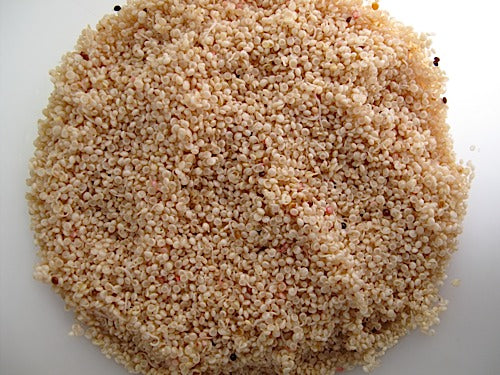
12 hours later... another Rinse/Drain cycle. Still going?
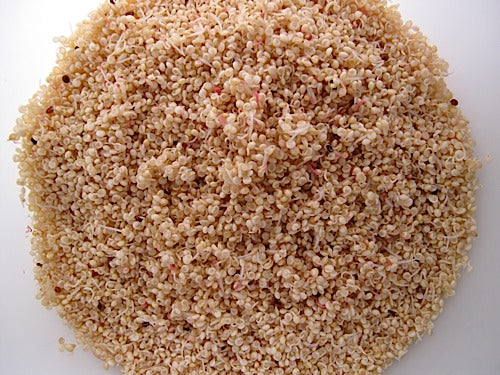
They are way too sprouted, but that's just our opinion. What do we know? If you do go this far, you will likely see some Root Hairs - which is fine. Remember to taste your seeds/sprouts at every opportunity, to determine at what stage you like them best.

Dry Amaranth awaits Soaking.

30 minutes later... Soaked, Rinsed and Drained thoroughly.

12 hours later... another Rinse/Drain cycle.Remember to be Thorough - especially in your Draining.

12 hours later... another Rinse/Drain cycle.Remember to be especially Thorough in your Draining, if you intend on following our advice - by harvesting in 12 hours.

12 hours later... We would be done, and our Amaranth sprouts consumed or stored, but you keep going if you must. If you must - it's time for anotherRinse/Drain cycle.

12 hours later... another Rinse/Drain cycle. You do what you have to - you are already past our advice....

12 hours later... another Rinse/Drain cycle. Still going?

They are way too sprouted, but that's just our opinion. What do we know? If you do go this far, you will likely see some Root Hairs - which is fine. Remember to taste your seeds/sprouts at every opportunity, to determine at what stage you like them best.
Yields approximately 1 Cup (1/2 lb.) of Sprouts
Seed Prep Measure out 2/3 Cup of seed* Rinse your seeds to remove dust or plant debris.
Soak Transfer your seeds - if necessary - into your Sprouter, or a bowl. Add 2-3 times as much cool (60-70 degree) water. Mix seeds up to assure even water contact for all. Allow seeds to Soak for 20-30 minutes. You don't really even need to Soak Amaranth, but it speeds it up a little to do so. It will appear to be water repellant, but it will actually take in water.
Sprouting Empty the seeds into your Sprouter (if necessary). Drain off the soak water. You can use it - it has nutrients in it.
Rinse thoroughly with cool (60-70°) water. Drain thoroughly.
Always be sure to Drain very thoroughly. The most common cause of inferior sprouts is inadequate drainage. Even the best designed Sprouting Device holds water, so pay special attention to this step.
Set your Sprouter anywhere out of direct sunlight and at room temperature (70° is optimal) between Rinses. This is where your sprouts do their growing. We use a counter top - in the corner of our kitchen, but where the sprouter won't get knocked over by cats, dogs, kids or us. We don't mind the indirect sunlight or the 150 watts of incandescent light, because light just does not matter much. These Sprouts will never have leaves, and a plant can only perform photosynthesis when it has leaves. Until then light has little if any effect, so don't hide your sprouts. Plus, they like air-circulation.
Rinse and Drain again in 8-12 hours. And, once more... Rinse and Drain again in 8-12 hours. And, perhaps once more... Rinse and Drain in 8-12 hours. And, possibly once more... Rinse and Drain in 8-12 hours.
We stop - usually sooner - but definitely no later then here. We like our sprouts small. Typically, we sprout for just 2-3 Rinse and Drain cycles. At that point most of the seeds will have sprouted tiny (barely visible) roots. That's the way we like these sprouts.
Depending on your climate and the time of year you are sprouting and most importantly your personal preference - You may Rinse and Drain again at 8-12 hour intervals for several days. We Do Not recommend doing so, unless you're doing a science experiment. Grow them for as long as you like. As long as you continue to Rinse and Drain every 8-12 hours.
Note: Amaranth can be sprouted quite a bit longer but it's texture changes profoundly, going from a soft crunchy sprout to a very soft sprout. If you sprout it long you'll have to use it soon as it won't keep well. Experiment! Have Fun! It's All Good - if occasionally inedible @;-D
As always, we suggest that you taste your crop at EVERY Rinse - including the very first - just after the Soak period. The soaked seeds are already alive and super nutritious - and - they are without enzyme inhibitors (a very good thing indeed!) so they'll digest themselves and nourish you. So taste them often and find out for yourself when they are most delicious! That's when they're done.
Harvest Your sprouts are done 8-12 hours after your final Rinse. Be sure to Drain them as thoroughly as possible after that final Rinse. The goal during the final 8-12 hours is to minimize the surface moisture of your sprouts - they will store best in your refrigerator if they are dry to the touch.
Refrigerate Transfer your sprout crop to a plastic bag or the sealed container of your choice and put them in your refrigerator. We offer Produce Storage Bags that will extend shelf life substantially. Note: Amaranth - when sprouted very short - can make it in refrigeration for up to 2 weeks. When sprouted longer expect less. If you can use 'em fresher we think you'll like them better.
*Seed to Use
* If using Sproutpeople's Single Harvest Pack - use the whole bag. It will produce a crop of approximately 8 ounces.
These seeds will yield approximately 1.5:1 (you get 1.5 pounds for every pound of dry seed), so in theory you can start with up to 2/3 as much dry seed, as your Sprouter has capacity. We generally advise maxing out at 1/2 capacity, until you get used to growing a particular crop.
Amaranth is an ancient pseudograin which has been used for millennia for its leaf and its seed. In the sprout world we generally use it as a seed, though it can be grown into Micro-Greens as well. We don't offer it as such because we find its flavor unpleasant. It is a very tasty sprout with a great texture - it sorta pops like popcorn when you bite down on it. It's a very tiny seed, which produces red-tinged sprouts whether you Soak it or not. You can toss some Amaranth Sprouts into or onto just about anything you eat. Their size is a great visual addition to any dish. Several studies have shown that Amaranth has a positive effect on a variety of ailments; hypertension, heart disease and cholesterol to name a few.
As of 2019 we are only selling straight Amaranth when we have an exceptional lot, so if it is in-stock you will know it is a good sprouter.
Make sure to use a Fine Mesh Screen, if using a Jar to sprout - or rhe Small Seed Insert if using Easy Sprout. If a few seeds escape don’t worry. The vast majority will not escape.
Seed Shelf Life: 2 years. Store in cool, dark, dry spot. Store in freezer to extend shelf life.
Soaking
You may soak your Amaranth if you like. I do so every so often. Usually I soak for 30-60 minutes when I do.
Seed Storage
Amaranth is best stored in a cool location - we keep ours in a freezer. If you plan on storing these for more than 6 months you should definitely freeze them. Amaranth is occasionally pleasing to a particular pest - the Indian Meal Moth, which can appear out of nowhere when conditions are right (hot). These are organic seeds after all, so there is no other way to keep your seeds absolutely safe, except to freeze them. Consider yourself further educated =:-}

